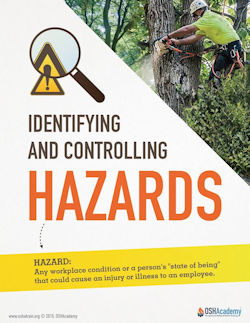Hazard Identification and Control
Introduction
In module four, we studied communication and how it can be used to improve employee involvement in the company's safety management system (SMS).
In this module, we'll discuss the programs, processes, and procedures for identifying, analyzing, and controlling hazards and exposure to hazards.
What is a "Hazard" and "Exposure?"
Before we study identifying, analyzing, and controlling hazards and exposure in the workplace, it's important to know how OSHA defines these terms.
A hazard is defined as "any workplace condition that could cause an injury or illness to an employee."
There are two forms of exposure to hazards:
- Physical exposure. When an employee is within arm's length of a hazard.
- Environmental exposure. The employee can be anywhere in relation to the hazard. Examples include noise, hazardous atmospheres, and temperature extremes. Environmental hazards could affect one employee or everyone within a facility.
Knowledge Check Choose the best answer for the question.
5-1. A workplace condition that could cause an injury or illness to an employee is defined as a/an _____.
You forgot to answer the question!

